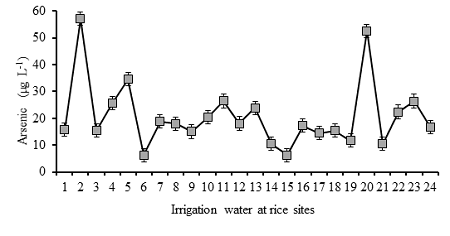


Indian Journal of Science and Technology
DOI: 10.17485/IJST/v13i14.149130
Year: 2020, Volume: 13, Issue: 14, Pages: 1505-1511
Original Article
Muhammad Chohan1, Mehrunisa Memon1*, Inayatullah Rajpar1, Aijaz Ali
Khooharo2, Muhammad Ismail Kumbhar2, Hidayatullah Kakar3
1Department of Soil Science, Sindh Agriculture University, Tandojam, Sindh, Pakistan
2Department of Agricultural Education, Extension and Short Courses, Sindh Agriculture
University, Tandojam, Sindh, Pakistan
3Agriculture Research Institute (ARI), Sariab Quetta, Pakistan
*Corresponding author
Mehrunisa Memon
Department of Soil Science, Sindh Agriculture University, Tandojam, Sindh, Pakistan
Email: [email protected]
Received Date:03 March 2020, Accepted Date:20 April 2020, Published Date:29 May 2020
Background/Objectives: Irrigation water at Phuleli and Akram canals carry the waste of Hyderabad city and other places on the way to rice fields at lower part of Indus Plain. The long term use of arsenic contaminated irrigation water can accumulate arsenic in rice soils. This study evaluated total arsenic in irrigation water and transported load to rice sites, in addition to the arsenic concentration in main canals and waste sites on the way to Badin. Methods: Atomic absorption spectrophotometer equipped with hydride vapor assembly was used to analyze the arsenic concentrations in irrigation water. Findings: Currently, the irrigation water quality was generally within the permissible limits of FAO for rice. All types of wastes (14.62-37.2 µg L-1) entering the Phuleli and Akram canals (7.08 µg L-1) on the way contributed to total arsenic (6.30-57.12 µg L-1) in irrigation water at the entrance of rice sites. However, higher arsenic contamination in irrigation water was due to sugar industry waste (37.2 µg L-1) and lowest due to city waste of Badin (14.62 µg L-1). The data indicated that mean total arsenic concentration from irrigation water would load 0.12 and 0.14 mg kg-1 of arsenic annually in soils on the basis of net 1000 and 1300 mm a-1 water application to rice, respectively. Applications/Improvements: The results clearly indicated that waste added from different sources may aggravate the arsenic contamination of canal water and yet the accumulation in rice fields will keep on increasing. It is suggested that waste must be treated before releasing to prevent contamination of rice field.
Keywords: Arsenic load, City waste, Contamination, Industrial waste
© 2020 Chohan, Memon, Rajpar, Khooharo, Kumbhar, Kakar. This is an open-access article distributed under the terms of the Creative Commons Attribution License, which permits unrestricted use, distribution, and reproduction in any medium, provided the original author and source are credited.
Published By Indian Society for Education and Environment (iSee)
Subscribe now for latest articles and news.